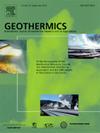Hydrochemistry and isotope geochemistry of Bailing geothermal water in northwest Jiangxi: Implications for water-rock interaction
IF 3.9
2区 工程技术
Q3 ENERGY & FUELS
引用次数: 0
Abstract
Geothermal energy development and utilization can contribute to the achievement of China's dual carbon goals and energy security. Bailing area in northwest Jiangxi province is abundant of geothermal manifestations like hot springs and geothermal wells. However, due to the limited understanding of the genetic mechanism of these geothermal resources, the utilization efficiency of these geothermal waters is not sufficient at present. In this study, the hydrochemcial characteristics and water-rock interaction process of geothermal waters of 3 typical hot springs and 3 geothermal wells in Bailing area were researched by using hydrogeochemistry, isotope geochemistry, multi-mineral equilibrium simulation and silicon enthalpy graphic method. The results show that the geothermal waters in Bailing area are HCO3-Na type weakly alkaline silicon-fluorine water with temperature 32.7–85 °C, pH 8.27–8.82, H2SiO3 77.74–115.36 mg/L and F- 3.74–5.47 mg/L. These geothermal waters have experienced a very strong water-rock interaction process, isotope and ion exchanges, resulting in the enrichment of ion component and trace elements (such as Al, B, Li, Sc, Ti, V, W, Rb, Ga, Mo, Cs and U). Geothermal waters originate from atmospheric precipitation with the recharge elevation varying from 243 m to 1455 m, and then infiltrated to depth about 4–5 Km to be heated along weathering fissures and secondary faults. The radioactive heat generation of granites provided the heat source and the reservoir temperature determined by quartz geothermometer ranges from 109.9 to 130.6 °C. After undergoing a deep circulation of 2483 to 3034 years, these geothermal waters emerged on the surface along the northeast-trending fault to form hot springs, and mixed with cold water (mixing ratio: 21 %-67 %) during the rising process. This research is helpful to provide a more comprehensive understanding of the origin, circulation and evolution of geothermal waters in Bailing area.
赣西北百陵地热水水化学与同位素地球化学:水岩相互作用意义
地热能的开发利用有助于实现中国的双碳目标和能源安全。赣西北百陵地区地热资源丰富,温泉、地热井等地热表现形式丰富。然而,由于对这些地热资源的成因机制认识有限,目前这些地热水的利用效率还不够高。利用水文地球化学、同位素地球化学、多矿物平衡模拟和硅焓图等方法,研究了百陵地区3个典型温泉和3口地热井地热水的水化学特征和水岩相互作用过程。结果表明:白陵地区地热水为HCO3-Na型弱碱性硅氟水,温度32.7 ~ 85℃,pH 8.27 ~ 8.82, H2SiO3 77.74 ~ 115.36 mg/L, F- 3.74 ~ 5.47 mg/L;这些地热水经历了非常强烈的水岩相互作用过程、同位素和离子交换,导致离子组分和微量元素(如Al、B、Li、Sc、Ti、V、W、Rb、Ga、Mo、Cs和U)富集。地热水来源于大气降水,补给高度在243 ~ 1455 m之间,然后沿风化裂缝和次生断裂渗透至深度约4 ~ 5 Km处受热。花岗岩的放射性生热提供了热源,石英地温计测得的储层温度范围为109.9 ~ 130.6℃。这些地热水经过2483 ~ 3034年的深部循环,沿东北向断裂向地表涌出形成温泉,并在上升过程中与冷水混合(混合比例为21% ~ 67%)。该研究有助于更全面地认识百陵地区地热水的成因、循环和演化。
本文章由计算机程序翻译,如有差异,请以英文原文为准。
求助全文
约1分钟内获得全文
求助全文
来源期刊

Geothermics
工程技术-地球科学综合
CiteScore
7.70
自引率
15.40%
发文量
237
审稿时长
4.5 months
期刊介绍:
Geothermics is an international journal devoted to the research and development of geothermal energy. The International Board of Editors of Geothermics, which comprises specialists in the various aspects of geothermal resources, exploration and development, guarantees the balanced, comprehensive view of scientific and technological developments in this promising energy field.
It promulgates the state of the art and science of geothermal energy, its exploration and exploitation through a regular exchange of information from all parts of the world. The journal publishes articles dealing with the theory, exploration techniques and all aspects of the utilization of geothermal resources. Geothermics serves as the scientific house, or exchange medium, through which the growing community of geothermal specialists can provide and receive information.
 求助内容:
求助内容: 应助结果提醒方式:
应助结果提醒方式:


